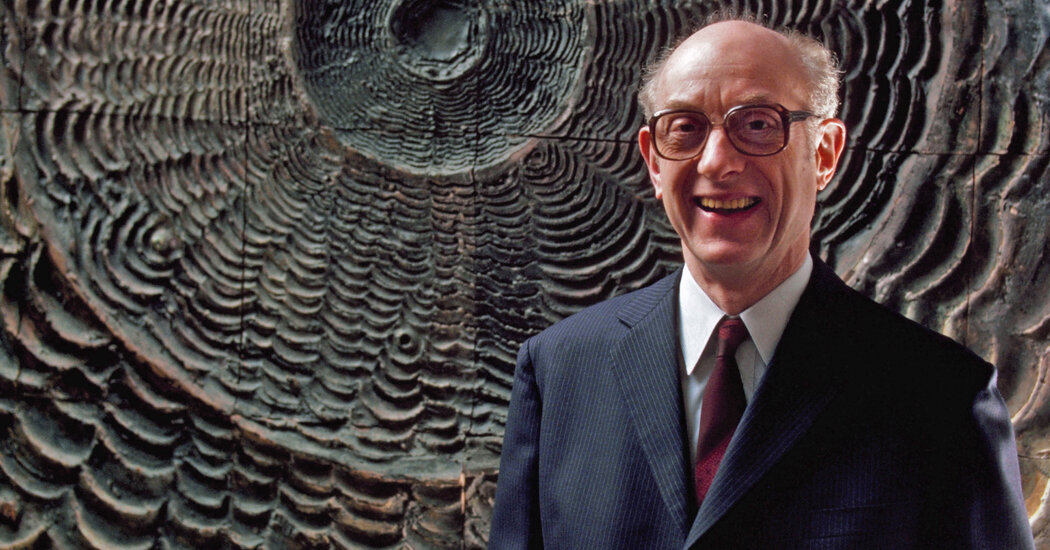Edward Anders, a cosmochemist who unraveled mysteries about the solar system and the wildfires that helped wipe out the dinosaurs — and who then, in retirement, uncovered the identities of thousands of Jews from his hometown who were killed in the Holocaust — died on June 1 in San Mateo, Calif. He was 98.
His death, in an assisted living facility, was confirmed by his son, George.
Professor Anders emigrated to the United States in 1949, a few months after being called to testify at the Nuremberg trials about Nazi brutality in Liepaja, Latvia, in 1941 — events that he and his mother survived after she tricked soldiers into believing that she was of Aryan descent. His father wasn’t as fortunate.
Settling in New York City, Edward enrolled at Columbia University and studied chemistry. One day, his professor — a curator at the American Museum of Natural History — brought a handful of meteorite rocks to pass around in class.
“I found them tremendously exciting,” Professor Anders said in a 2001 interview with the journal Meteoritics & Planetary Science. “I would even use the word romantic. Here were samples from far beyond the Earth’s orbit, older than any rock on Earth, and you can get your hands on them, and even do respectable research on them.”
Professor Anders’s research turned out to be more than merely respectable. At the University of Chicago, his academic home for more than 30 years beginning in 1955, he conducted a series of groundbreaking studies into the early history of the solar system.
He demonstrated that meteorites were fragments from asteroids and not, as was believed at the time, debris from the moon or comets. He quantified the elements of the solar system in a journal article that has been cited more than 14,000 times. And he uncovered evidence of the global wildfires that helped lead to the dinosaurs’ extinction.
“I find it hard to conceive of our science without Ed Anders,” Michael J. Drake, a planetary science professor at the University of Arizona, said in a speech in 1990 in which he presented Professor Anders with the V.M. Goldschmidt Award, the top honor of the Geochemical Society.
Professor Anders spoke about the cosmos whimsically, with a sense of curiosity and awe.
In an interview with Discover magazine in 1991, he marveled at the rather mind-bending notion that everything about Earth — on it, in it, under it, around it — was unoriginal. “The material in the solar system is secondhand,” he said. “All of it originally was older than the solar system, but most of it has been reprocessed.”
He called meteorites “the poor man’s space probe,” because they deliver pieces of asteroids that scientists are able to study without traveling to outer space. The mysteries in the stardust they carry — of diamonds, graphite and silicon carbide — are never-ending, like the stars.
“What was the raw material of the solar system?” he asked in the Discover interview. “Where did it come from? What were the nuclear and chemical processes in the parent stars? And how was this material altered in the early solar system?”
Professor Anders spent his life trying to answer these celestial, seemingly impossible questions, even as painful, seemingly inexplicable ones about his childhood haunted him.
Edward Alperovitch was born on June 21, 1926, in Liepaja and changed his surname to Anders when he became a naturalized U.S. citizen in 1955. His father, Adolph Alperovitch, was a merchant. His mother, Erica (Sheftelovitch-Meiran) Alperovitch, was a file clerk.
When Edward was 14 years old, Soviet forces occupied Latvia, and his parents were forced to rent rooms in their apartment to Russian border guards. In June 1941, the Soviets began mass deportations to Russia. Edward’s family was on the deportation list and received orders to pack their belongings.
One of their border-guard tenants, feeling sympathy for the family, removed them from the list. “For the moment, we were saved,” Professor Anders recalled in 1997 in an oral history interview for the United States Holocaust Memorial Museum in Washington.
After Germany invaded the Soviet Union and occupied Latvia, Jews faced restrictions on their movements and on their ability to practice their faith. Several hundred were massacred in a local park during a Nazi rampage. Edward and his family thought their days were numbered.
Then his father had an idea: Concoct a story about how his wife was not the biological child of Jewish parents, but rather an Aryan found on their doorstep in a basket with a note saying that she had been baptized. That made Edward and his brother half-Jews — “only second class rather than total outcasts,” he said in the museum oral history.
“It was an absolutely crazy story for us to start,” he added, “extremely audacious.”
It worked, but not for Edward’s father, who had essentially sacrificed himself as part of the plan. He hid in the family’s apartment but was discovered in November 1941 and arrested. A week later, a firing squad executed him.
The “half-Jew” ruse continued for several years, and it ultimately spared Edward, along with his mother and brother, from a trip to a Nazi death camp.
“If we had any inkling that the war was going to last another four years, we never would have tried this plan, because this is a lie that simply couldn’t go on for four years,” he said. “We were just playing for time. Well, it worked, all right.”
Edward never finished high school, nor did he receive a bachelor’s degree. After the war, he studied chemistry at a school in Munich affiliated with the United Nations. He later taught himself chemistry as a lab assistant at the University of Munich. After emigrating to the United States, he earned a doctorate from Columbia in 1954.
Throughout his career as a cosmochemist, Professor Anders rarely, if ever, spoke about his childhood. “You file it away in the proper place,” he said. “You know where to find it when you need it. The file drawers don’t pop open spontaneously.”
But after retiring, he began to revisit his memories in greater detail. He wrote a memoir, “Amidst Latvians During the Holocaust” (2011), and created a database of the more than 7,000 Jews who were alive in Liepaja when the Germans rolled in.
“Most Holocaust victims have become nameless statistics,” he wrote in the journal Holocaust and Genocide Studies. “That would have pleased Hitler.”
Using government documents, directories, diaries and other materials he found in archives, Professor Anders cataloged what happened to thousands of Jews in his town. He gave them back their names.
“Edward always saw himself as a bridge builder between past and present, between Jews and non-Jews, between the continents,” Uwe Neumärker, a historian who helped arrange for Professor Anders’s memoir to be published in German, said by email.
Professor Anders married Joan Fleming in 1955. She died in 2019. In addition to his son, George, he is survived by a daughter, Nanci Schiman; five grandchildren; and three great-grandchildren. His brother, Georg, died of diphtheria in 1944.
Professor Anders was raised Jewish but described himself as agnostic.
“In a way, peering into the solar system had an almost a spiritual component for him,” his son said in an interview. “This was the creation story, and the creation story was pretty exciting and pretty amazing and pretty mysterious.”
The post Edward Anders, Who Duped Nazis and Illuminated the Cosmos, Dies at 98 appeared first on New York Times.




